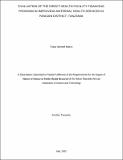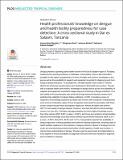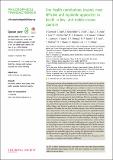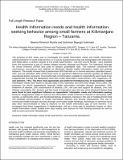Evaluation of the direct health facility financing program in improving maternal health services in Pangani district, Tanzania
| dc.contributor.author | Marco, Tukay | |
| dc.date.accessioned | 2022-08-29T11:29:42Z | |
| dc.date.available | 2022-08-29T11:29:42Z | |
| dc.date.issued | 2022-07 | |
| dc.identifier.uri | https://doi.org/10.58694/20.500.12479/1522 | |
| dc.description | A Dissertation Submitted in Partial Fulfilment of the Requirements for the Degree of Master of Science in Public Health Research of the Nelson Mandela African Institution of Science and Technology | en_US |
| dc.description.abstract | Maternal morbidity and mortality remain significant public health concerns globally, with Tanzania reporting 524 deaths per 100 000 live births annually in 2022. While national level data provide some insights into the issue, a focus on sub-national levels is required because of differences in contexts such as rural-urban disparities in maternal mortality. This study examined Direct Health Facility Financing (DHFF) and its effects on the quality of maternal health services in Pangani, a rural district in Tanzania. The study used qualitative and quantitative methods. Direct disbursement of funds from the central government through the Ministry of Finance and Planning to the primary health facilities reduced delays in procurement, improved community outreach services, and improved community leaders’ engagements. Deliveries occurring at health facilities increased by 33.6% (p<0.001) one year after the DHFF implementation. Various medicines, delivery kits, and some reagents increased significantly (p<0.05). However, unavailability of computers and poor internet connectivity, insufficient supply of medical equipment and stock out at Medical Stores Department increased the difficulty of obtaining the missed items from the selected prime vendor. Overall, this study shows a positive impact of the DHFF on maternal health service delivery in Pangani district. Specifically, increase in the number of medical supplies, equipment, and reagents necessary to provide maternal health services contributed to the observed increase in facility deliveries by a third. Moreover, the system minimizes unnecessary delays in the procurement processes of required drugs, supplies, and other facility reagents. To maximize the impact of the DHFF system, unavailability of computers, unstable internet, limited knowledge of the staff about the system, and inadequate health workforce should be addressed. Furthermore, training could include refreshers models on DHFF implementation. | en_US |
| dc.language.iso | en | en_US |
| dc.publisher | NM-AIST | en_US |
| dc.subject | Health Financing | en_US |
| dc.subject | Direct Health Facility Financing | en_US |
| dc.subject | Health Governing Committee | en_US |
| dc.subject | Maternal Health | en_US |
| dc.subject | Quality of Care | en_US |
| dc.title | Evaluation of the direct health facility financing program in improving maternal health services in Pangani district, Tanzania | en_US |
| dc.type | Thesis | en_US |




